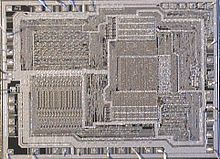
Back ইণ্টেল ৮০৮৫ Assamese इंटेल 8085 Bihari Intel 8085 Catalan Intel 8085 Czech Intel 8085 German Intel 8085 Greek Intel 8085 Spanish Intel 8085 Estonian اینتل ۸۰۸۵ Persian Intel 8085 Finnish
 An Intel P8085AH-2 processor variant with black plastic and silver pins | |
| General information | |
|---|---|
| Launched | March 1976 |
| Discontinued | 2000[1] |
| Common manufacturer(s) |
|
| Performance | |
| Max. CPU clock rate | 3, 5 and 6 MHz |
| Data width | 8 bits |
| Address width | 16 bits |
| Architecture and classification | |
| Technology node | 3 μm |
| Instruction set | 8085 |
| Physical specifications | |
| Transistors |
|
| Package(s) |
|
| Socket(s) | |
| History | |
| Predecessor(s) | Intel 8080 |
| Successor(s) | Intel 8086 |
| Support status | |
| Unsupported | |
The Intel 8085 ("eighty-eighty-five") is an 8-bit microprocessor produced by Intel and introduced in March 1976.[2] It is the last 8-bit microprocessor developed by Intel.
It is software-binary compatible with the more-famous Intel 8080 with only two minor instructions added to support its added interrupt and serial input/output features. However, it requires less support circuitry, allowing simpler and less expensive microcomputer systems to be built.
The "5" in the part number highlighted the fact that the 8085 uses a single +5-volt (V) power supply by using depletion-mode transistors, rather than requiring the +5 V, −5 V and +12 V supplies needed by the 8080. This capability matched that of the competing Z80, a popular 8080-derived CPU introduced the year before. These processors could be used in computers running the CP/M operating system.
The 8085 is supplied in a 40-pin DIP package. To maximise the functions on the available pins, the 8085 uses a multiplexed address/data (AD0-AD7) bus. However, an 8085 circuit requires an 8-bit address latch, so Intel manufactured several support chips with an address latch built in. These include the 8755, with an address latch, 2 KB of EPROM and 16 I/O pins, and the 8155 with 256 bytes of RAM, 22 I/O pins and a 14-bit programmable timer/counter. The multiplexed address/data bus reduced the number of PCB tracks between the 8085 and such memory and I/O chips.
Both the 8080 and the 8085 were eclipsed by the Zilog Z80 for desktop computers, which took over most of the CP/M computer market, as well as a share of the booming home-computer market in the early-to-mid-1980s.
The 8085 had a long life as a controller, no doubt thanks to its built-in serial I/O and five prioritized interrupts, arguably microcontroller-like features that the Z80 CPU did not have. Once designed into such products as the DECtape II controller and the VT102 video terminal in the late 1970s, the 8085 served for new production throughout the lifetime of those products. This was typically longer than the product life of desktop computers.

- ^ "The Life Cycle of a CPU". www.cpushack.com.
- ^ "Intel® Microprocessor Quick Reference Guide - Year". www.intel.com.
© MMXXIII Rich X Search. We shall prevail. All rights reserved. Rich X Search